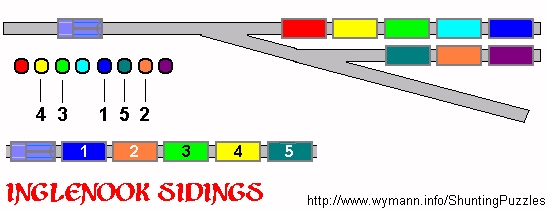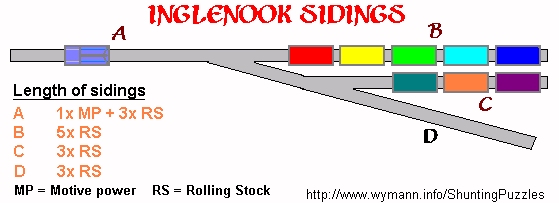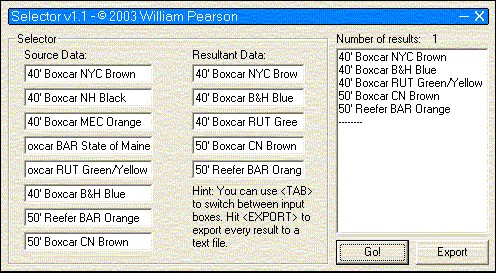|
|
| |
INGLENOOK
SIDINGS
RULES
& OPERATION
|
| |
|
| |
| |
The object of the Inglenook
Sidings shunting puzzle is fairly simple, the order for
the shunting crew being:
"Form a
departing train consisting of 5 out of the 8 wagons
sitting in the sidings."
In addition (and this is where
the "game element" of the puzzle comes in) the
shunting order states:
"The 5 wagons
are selected at random."
On the original Inglenook
Sidings, Alan Wright employed what he called the
"Tiddlywink Computer" for this task, i.e.
distinct tokens for each wagon drawn from a mug. No
matter how these 5 items of rolling stock are determined,
the order in which this happens is important because:
"The train must
be made up of the 5 wagons in the order in which they
are selected."
Here's an example of what this
can look like, illustrating that despite its simplicity,
this shunting puzzle can produce some combinations which
require a certain amount of thinking and a number of
moves.
|
| |
 |
|
The
challenge of fulfilling this shunting order is
linked to the fact that some advance thinking is
required - due to the fact that there is limited
space available to juggle around the rolling
stock, as determined by the lengths of the
individual sidings and the headshunt. What looks like a simple task can
thus provoke quite a bit of headscratching. And
since the number of possible combinations
regarding the positions of these 8 items of
rolling stock amounts to 40,320, it should take a
while before a feeling of "oh yes, I know
this one" grabs the operator.
|
|
| |
| Once
the train is made up, the five items of
rolling stock are either simply
redistributed on the sidings wherever
there is room for them, or replaced with
five other items if the headshunt leads
to somewhere, e.g. a fiddleyard or
perhaps even a larger layout. You can get a
first-hand impression of what it's like
to operate an "Inglenook
Sidings" layout straight away,
thanks to Neil Machin's virtual
"Inglenook Sidings" shunting
puzzle (which in itself has become a
small internet classic).
|
|
 |
|
|
| |
| Whilst it is one of
the strong points of the Inglenook Sidings shunting
puzzle that the tokens needed to identify the individual
cars can be as low-tech as imaginable (indeed, eight torn
out pieces of paper with the characteristics of the
individual cars scribbled down are all you need), you
could also have a computer do the shuffling for you -
which is precisely what the Inglenook Random Wagon
Selector by William Pearson will do. |
| |
 |
|
This
neat little piece of software dates from 2003 (it
will still run fine on most hardware running
Windows OS), and the screenshot shows an example
list of cars on the layout and how the Selector
produces a random list of cars in the order in
which they are to be shunted (courteousy of and
with the kind permission of Mark Kendrickng you
can still download it from this site as a zip-file. Or, if you prefer, you
can input your rolling stock into an online
random list generator and have your shunting
order made up in your web browser by simply
ignoring the last three items in the list (one
example is the List Randomizer from random.org).
|
|
| |
|
| |
INGLENOOK SIDINGS SOLUTION
STRATEGIES
|
| |
| A question often asked
by both newcomers and veterans is whether or not
there is a "best way" to tackle the
Inglenook Sidings shunting puzzle. While best
may be a matter of subjective opinion, there is
certainly a systematic way of looking at
how to solve a specific Inglenook Sidings
problem. |
| |
| Rule
of Thumb #1: "Get the
whole picture" |
| |
| In order to understand
the systematics of the Inglenook Sidings shunting
puzzle you need to take into account that there
are 14 slots available where rolling stock can be
placed at the end of a shunting move. 
8 of these slots are
occupied by rolling stock, leaving you with 6
free slots at all time. Try to focus not only on
the freight stock (i.e. the occupied slots) -
think of the free slots as items you can
"move around" too. There is a moment in
each randomly selected setup when having the free
slots in the right places can be more important
than where the freight stock actually is.
Remember: the free slots define which piece of
rolling stock can be moved where.
|
|
| Rule
of Thumb #2: "Clear
the way" |
| |
| Next, focus on the
occupied slots which are not part of the setup
you need to put together in order to solve the
task you have been given (for the sake of
clarity, the locomotive is always shown in the
same position; when solving a real puzzle task,
there is of course no need to move the locomotive
to its starting point after each move). 
You need to be able to
move rolling stock around in order to
successfully solve an Inglenook Sidings puzzle.
In other words: it is important to get those cars
out of the way which are in your way. The setup
chosen to illustrate this principle makes this
obvious: there isn't a single piece of rolling
stock which you need to assemble into the order
1-2-3-4-5 which is accessible to begin with. So,
you need to get the surplus cars (black) out of
the way first before you can do anything else.

Other possible
configurations may tempt you to start shuffling
cars into the required order straight away, but
unless you really have enough free slots to move
around, all unwanted pieces of rolling stock
should be moved to positions where they don't
block moves.

|
|
| |
| Rule
of Thumb #3: "Count
backwards" |
| |
| Once you can reach the
required pieces of rolling stock, it is important
to have a clear strategy. Placing car #3 in front
of car #4 won't really help unless you can fit
the other cars around this formation. It is
generally easier to back up cars to the buffer
stops than to build up the string of rolling
stock from the loco end. In other words: count
backwards, try to set off car #5 at the end of
one spur and then add the appropriate cars to
this. If that's not possible, try doing the same
thing with car #4. In
our example setup, the positions of cars #5 and
#4 need to be switched first.






With cars #4
and #5 in their correct sequence, attention now
turns to the remaining three cars which, for the
sake of illustration, have been placed in the
most awkward positions - they're exactly the
wrong way round, requiring the maximum moves to
get them in the right order.


At
this point, you need to remind yourself of rule
of thumb #1 - make the empty slots part of your
moves. In this case, this means coupling up to
some of the rolling stock which is not part of
the required configuration in order to gain room
for shunting moves.








You can now
back on to car #1, couple up, advance, back up to
car #3, couple up, and your train is ready to
depart with all cars in their correct order.

Now, that
wasn't too difficult was it - how about another
game...?
|
|
| |
|
| |
| |


|
| |
Back to the Model Railways
Shunting Puzzles Website main page

|
| |
|
| |
Page
created: 01/MAY/2001
Last revised:06/NOV/2022
|































